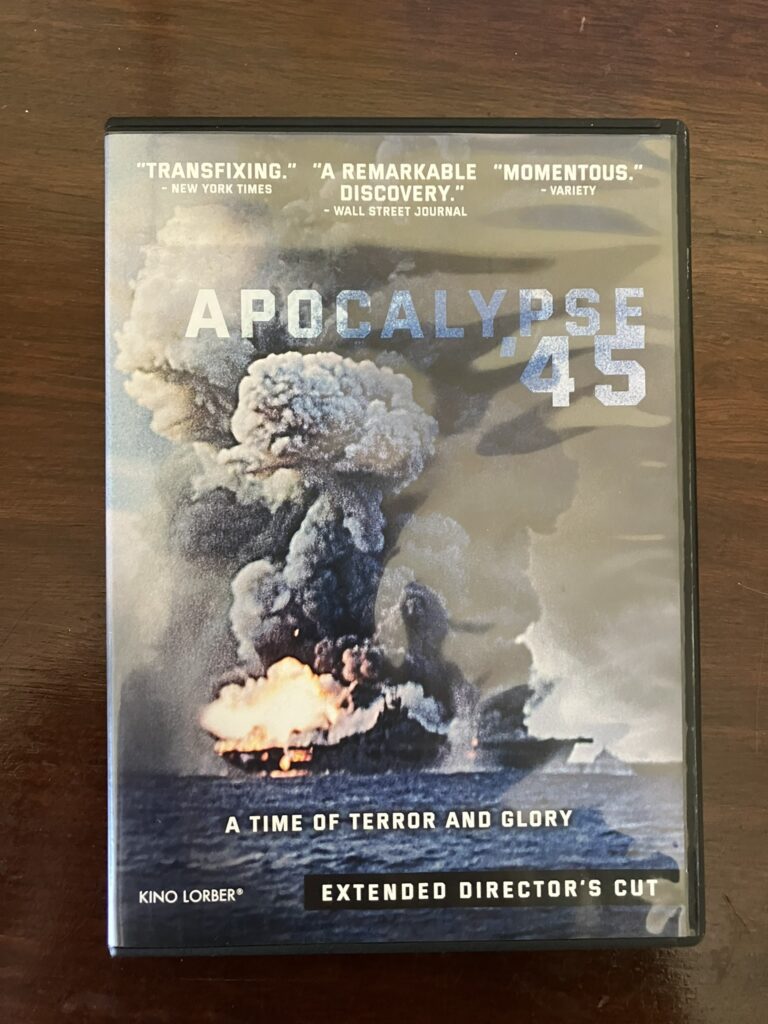Yes, USS Franklin Appears In “Apocalypse ‘45” Documentary

Director Erik Nelson has crafted Apocalypse ’45, a documentary about the final eight months of World War II in the Pacific Theater of Operations (PTO). Originally released several years ago, it’s now available on DVD. As part of my research on my book about Big Ben and its crew, I watched it last night.
What I Liked
I have seen many documentaries about World War II. Apocalypse ’45 is in a category by itself. First, the narration is sparse, given solely by 24 veterans. They were there at the battles and events the footage shows.
Second, there is no censorship here, as in The Fighting Lady and other documentaries made during or immediately after the war. You’ll get a view of war that most people have never seen. CAUTION: This documentary shows dead and dismembered bodies of Americans and Japanese, military, and civilian. There is footage of burn victims from the atomic bombings that may be difficult for some to see. I would not show this to children.
Third, although Franklin only occupies a little over two minutes, this documentary helps put her events in the larger context of the times. Many people thought that, by 1945, Japanese resistance was collapsing. While its defensive perimeter was shrinking, this part of the war was every bit as savage as it was in 1942.
I don’t have any quibbles with the accuracy, Ian Toll was the historian consultant, and he has written a well-respected trilogy on the Pacific War. Franklin’s story is slightly out of chronological sequence; it was included in a segment on the Navy’s actions during the battle of Okinawa.
The Remastering of the Footage Is Very Impactful
Apocalypse ’45 uses footage shot by frontline Army, Navy, and Marine Corps film crews. It has been remastered for widescreen and adapted for 4K viewing. The footage is housed at the National Archives, and you may have seen some of it before in its original format. This version was, to me, much more impactful. For example, there is about a minute’s worth of footage showing multiple explosions on Big Ben. I had seen this footage numerous times in its original format but when I saw it in the documentary, my reaction was “Holy @#^&! How did anyone survive that?!”
Watch The Extras
In addition to the documentary, there are seven “extras.” The first contains film footage shot by legendary Hollywood director John Ford at Pearl Harbor and Midway Island (during the Battle of Midway). There are also several shorter documentaries, one on Iwo Jima made during the war, the other about B-29s bombing Japan made later in 1945 after the war ended. An alternate credit roll, the trailer for this documentary, and one for The Cold Blue, an earlier documentary about B-17 crews in the European Theater of Operations (ETO) are also included.
A little-known thing I learned while researching this documentary was that one of the narrators was Pharmacist’s Mate/1c Maurice “Doc” Hubert. He was on Iwo Jima, Okinawa, and participated in three other assaults. He tended to Ernie Pyle, the newspaper correspondent, as Pyle lay dying, machine-gunned on an island near Okinawa. This resonated with me as my father, a combat veteran in the ETO, often told me of his love and respect for two correspondents. One was cartoonist Bill Mauldin; the other was Ernie Pyle.
My Recommendation
As mentioned earlier, there is only about two minutes total of footage on Franklin. There is a short clip of Father Joe giving last rites to Bob Blanchard. and some additional footage shot from the flight deck. The footage of the explosions is powerful. “Haunting” might be a better word, but there is no discussion of the controversy aboard the ship.
For the footage, and to put 1945 into context, I recommend this documentary. It can be tough to watch, and it’s not done in a “traditional” WWII documentary style. If you still have a DVD player, you can purchase the documentary on Amazon or at Kino Lorber, an independent film distributor.
Did you arrive here via a search engine? I am the author of the forthcoming book, Heroes By The Hundreds: The Story of the USS Franklin (CV-13). In addition to writing about the bravery of the crews that saved her, I will be writing about the lessons we can learn in leadership and crisis management. I’ll also write about the changes the US Navy made because of those lessons learned.
I send out a monthly newsletter, Glenn’s After-Action Report, writing about subjects I find interesting in my research. I hope you will sign up for it below. Feel free to leave a comment or ask a question. Thanks for reading.-Glenn